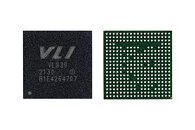- Joined
- Oct 9, 2007
- Messages
- 47,849 (7.39/day)
- Location
- Dublin, Ireland
| System Name | RBMK-1000 |
|---|---|
| Processor | AMD Ryzen 7 5700G |
| Motherboard | Gigabyte B550 AORUS Elite V2 |
| Cooling | DeepCool Gammax L240 V2 |
| Memory | 2x 16GB DDR4-3200 |
| Video Card(s) | Galax RTX 4070 Ti EX |
| Storage | Samsung 990 1TB |
| Display(s) | BenQ 1440p 60 Hz 27-inch |
| Case | Corsair Carbide 100R |
| Audio Device(s) | ASUS SupremeFX S1220A |
| Power Supply | Cooler Master MWE Gold 650W |
| Mouse | ASUS ROG Strix Impact |
| Keyboard | Gamdias Hermes E2 |
| Software | Windows 11 Pro |
VIA Labs, Inc. (VLI), a leading supplier of SuperSpeed USB, USB Power Delivery Controllers, and now USB4 controllers today unveiled the VIA Labs VL830 USB4 Endpoint Device. USB4 is a major update to the USB architecture, enabling multiple simultaneous data and display protocols to share a single high-speed link with support for a maximum aggregate bandwidth of 40 Gbps. VL830 offers both USB and DisplayPort functionality and operates at full performance when used with Thunderbolt 4 or USB4 systems, and is also backward compatible with previous-generation devices such as laptops, tablets, and phones that support DisplayPort Alternate Mode over USB Type-C.
"VIA Labs VL830 represents a culmination of our experience in developing USB Type-C, USB Power Delivery, and USB 3.2 products, an industry leader in time to market, and contribution and participation in standards development," said Terrance Shih, Business Development Director, VIA Labs, Inc. "USB4 is based on Thunderbolt technology and we are very excited to deliver these capabilities at new price points."



The VIA Labs VL830 USB4 Endpoint Device offers up to double the video bandwidth compared to DisplayPort Alternate Mode over USB Type-C and can simultaneously support up to a single 8K 60 Hz high-dynamic-range display and several USB 3.2 Gen2 devices, depending on the host system's capabilities. When paired with a DisplayPort Multi-Stream Transport hub, multiple 4K or high-refresh-rate displays can be supported while still enjoying fast SuperSpeed USB data transfers.
VIA Labs VL830 Availability
The VIA Labs VL830 features an integrated USB 3.2 Gen 2 hub with five downstream ports and a DisplayPort 1.4a output, and it can fully utilize the full 40 Gbps of bandwidth offered by USB4. VL830 comes in compact FCCSP 10 mm x 10 mm package.
The VIA Labs VL830 is already seeing early adoption in USB-C docking station, multi-function adapter, and other product categories. VIA Labs VL830 will be begin shipping to select partners in Q4, 2021.
For more information about the VIA Labs VL830, please visit this page.
View at TechPowerUp Main Site
"VIA Labs VL830 represents a culmination of our experience in developing USB Type-C, USB Power Delivery, and USB 3.2 products, an industry leader in time to market, and contribution and participation in standards development," said Terrance Shih, Business Development Director, VIA Labs, Inc. "USB4 is based on Thunderbolt technology and we are very excited to deliver these capabilities at new price points."



The VIA Labs VL830 USB4 Endpoint Device offers up to double the video bandwidth compared to DisplayPort Alternate Mode over USB Type-C and can simultaneously support up to a single 8K 60 Hz high-dynamic-range display and several USB 3.2 Gen2 devices, depending on the host system's capabilities. When paired with a DisplayPort Multi-Stream Transport hub, multiple 4K or high-refresh-rate displays can be supported while still enjoying fast SuperSpeed USB data transfers.
VIA Labs VL830 Availability
The VIA Labs VL830 features an integrated USB 3.2 Gen 2 hub with five downstream ports and a DisplayPort 1.4a output, and it can fully utilize the full 40 Gbps of bandwidth offered by USB4. VL830 comes in compact FCCSP 10 mm x 10 mm package.
The VIA Labs VL830 is already seeing early adoption in USB-C docking station, multi-function adapter, and other product categories. VIA Labs VL830 will be begin shipping to select partners in Q4, 2021.
For more information about the VIA Labs VL830, please visit this page.
View at TechPowerUp Main Site





